Production of Lipase and Biosurfactant by Isolated from Wastewater Dairy
DOI:
https://doi.org/10.5433/2316-5200.2012v1n1p28Keywords:
Lipase, biosurfactant, bioremediationAbstract
Lipases and biosurfactants are useful tools in the decontamination of polluted environments with lipid residues can be obtained from microbiological sources. The objective of this study was to evaluate the production of lipase and biosurfactant of isolated from wastewater of a dairy called ISO 6. Different vegetable oil 1% were tested as carbon source for production of lipase and biosurfactant. The lipolytic activity was quantified by measuring p-nitrophenol released after 10 minutes of incubation of the enzyme with p-nitrophenyl palmitate at 37 ° C and pH 8, 5. To determine emulsification index 2 mL of crude extract was mixed with 2 mL of kerosene and after shaking on vortex for 2 minutes was calculated the ratio between the height of the emulsified layer divided by the total height of the liquid column. The best carbon source for the production of lipase was corn oil (75.81 IU / mL) but it was not a good substrate for production of the biosurfactant, for the lowest rate of emulsification was obtained with this vegetable oil. In all experiments the isolated ISO 6 was able to produce biosurfactant and lipase showing potential for use in bioremediation of polluted environments with lipid residues.

